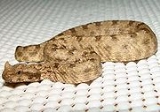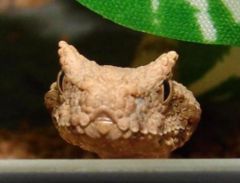
Pseudocerastes persicus fieldi
Encyclopedia
- Common names: Field's horned viper.
Pseudocerastes persicus fieldi is a venomous
Venomous snake
"Poisonous snake" redirects here. For true poisonous snakes, see Rhabdophis.Venomous snakes are snakes which have venom glands and specialized teeth for the injection of venom...
viper
Viperinae
The Viperinae, or viperines, are a subfamily of venomous vipers found in Europe, Asia and Africa. They are distinguished by their lack of the heat-sensing pit organs that characterize their sister group, the Crotalinae. Currently, 12 genera and 66 species are recognized...
subspecies
Subspecies
Subspecies in biological classification, is either a taxonomic rank subordinate to species, ora taxonomic unit in that rank . A subspecies cannot be recognized in isolation: a species will either be recognized as having no subspecies at all or two or more, never just one...
found in the deserts of the Middle East
Middle East
The Middle East is a region that encompasses Western Asia and Northern Africa. It is often used as a synonym for Near East, in opposition to Far East...
. The main differences between this subspecies and the nominate race are in scalation and venom composition.
Description
Outwardly, P. p. fieldi differs from P. p. persicusPseudocerastes
Pseudocerastes is a monotypic genus created for a venomous viper species, P. persicus. This species is found throughout the Middle East and as far east as Pakistan, but not on the African mainland. Often referred to as the false horned viper because of the hornlike structures above their eyes that...
only in certain (lower) scale counts:
| P. p. fieldi | P. p. persicus | |
|---|---|---|
| Scales separating nasal and rostral | 1 | 2 |
| Midbody dorsals | 21-23 | 23-25 |
| Ventral scales Ventral scales In snakes, the ventral scales are the enlarged and transversely elongated scales that extend down the underside of the body from the neck to the anal scale. When counting them, the first is the anteriormost ventral scale that contacts the paraventral row of dorsal scales on either side... |
127-142 | 144-158 |
| Subcaudal scales Subcaudal scales In snakes, the subcaudal scales are the enlarged plates on the underside of the tail. These scales may be either single or divided and are preceded by the anal scale.... |
34-46 | 38-48 |
Geographic distribution

Sinai Peninsula
The Sinai Peninsula or Sinai is a triangular peninsula in Egypt about in area. It is situated between the Mediterranean Sea to the north, and the Red Sea to the south, and is the only part of Egyptian territory located in Asia as opposed to Africa, effectively serving as a land bridge between two...
, Israel
Israel
The State of Israel is a parliamentary republic located in the Middle East, along the eastern shore of the Mediterranean Sea...
, Jordan
Jordan
Jordan , officially the Hashemite Kingdom of Jordan , Al-Mamlaka al-Urduniyya al-Hashemiyya) is a kingdom on the East Bank of the River Jordan. The country borders Saudi Arabia to the east and south-east, Iraq to the north-east, Syria to the north and the West Bank and Israel to the west, sharing...
, northern Saudi Arabia
Saudi Arabia
The Kingdom of Saudi Arabia , commonly known in British English as Saudi Arabia and in Arabic as as-Sa‘ūdiyyah , is the largest state in Western Asia by land area, constituting the bulk of the Arabian Peninsula, and the second-largest in the Arab World...
, northwestern Iraq
Iraq
Iraq ; officially the Republic of Iraq is a country in Western Asia spanning most of the northwestern end of the Zagros mountain range, the eastern part of the Syrian Desert and the northern part of the Arabian Desert....
and possibly in southern Syria. The type locality given in the original description is "Blair Wells, Transjordania" [Jordan].
According to Mallow et al. (2003): the Sinai Peninsula, southern Israel, Jordan, extreme northern Saudi Arabia and southwestern Iraq.
Venom
There is a more pronounced difference between the two subspecies with regard to their venom. While P. p. persicusPseudocerastes
Pseudocerastes is a monotypic genus created for a venomous viper species, P. persicus. This species is found throughout the Middle East and as far east as Pakistan, but not on the African mainland. Often referred to as the false horned viper because of the hornlike structures above their eyes that...
venom exhibits strong hemorrhagic activity typical of most vipers
Viperidae
The Viperidae are a family of venomous snakes found all over the world, except in Antarctica, Australia, Ireland, Madagascar, Hawaii, various other isolated islands, and above the Arctic Circle. All have relatively long, hinged fangs that permit deep penetration and injection of venom. Four...
, the venom of P. p. fieldi is unusual in that contains several fractions that show marked neurotoxic activity. No antivenin
Antivenin
Antivenom is a biological product used in the treatment of venomous bites or stings. Antivenom is created by milking venom from the desired snake, spider or insect. The venom is then diluted and injected into a horse, sheep or goat...
is available for bites from either subspecies. It is reported that a polyvalent antiserum does offer some protection from the hemotoxins, but none against the neurotoxic effects of P. p. fieldi venom.

